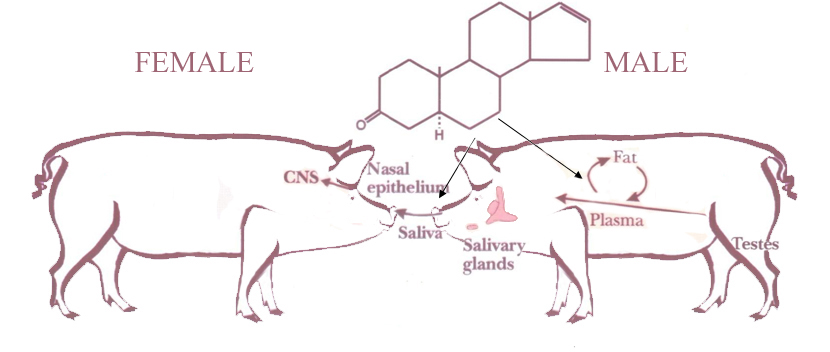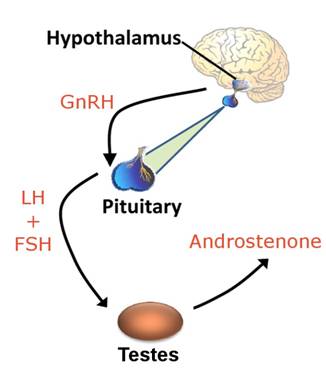Androstenone
Androstenone is a testicular steroid with no hormonal activity produced in mature male pigs in parallel with anabolic hormones (see figure 4). Some androstenone accumulates in the back-fat (adipose tissue) and produces boar taint when heated. The levels of androstenone are regulated by the stage of puberty and the individual ability of the animal to synthesize and metabolize androstenone. In the regulation of androstenone levels, dietary factors are believed to be less important than for the skatole levels.

Figure 4: Schematic illustration on the production of androstenone. Source: Maria Algers.
After being produced by the Leydig cells, androstenone is either transported to the liver, where it is metabolized and excreted, or it is transported to the salivary gland where it is released in the saliva. There it is bound to a specific binding protein and serves as a pheromone to attract the sows in oestrus and induce a mating response. The third pathway is when androstenone is transported by the blood to the fat tissue, resulting in boar taint.
Production of androstenone is controlled by the neuroendocrine system, especially by the luteinizing hormone (LH), which is controlled by the gonadotropin-releasing hormone (GnRH), see Figure 5.
The control of sexual functions in both the male and female pigs starts with secretion of gonadotropin-releasing hormone (GnRH) by the hypothalamus. This hormone stimulates the anterior pituitary gland to secrete the two hormones luteinizing hormone (LH) and follicle-stimulating hormone (FSH). LH is the primary stimulus for the secretion of testosterone by the testes, whereas FSH helps to stimulate spermatogenesis.

Figure 5: Schematic illustration on the production of androstenone. Source: Improvac
Recent research shows that a human receptor is involved in consumer´s sensitivity to androstenone and further research in this field will aid consumer studies in the future (Lundström et al., 2009).